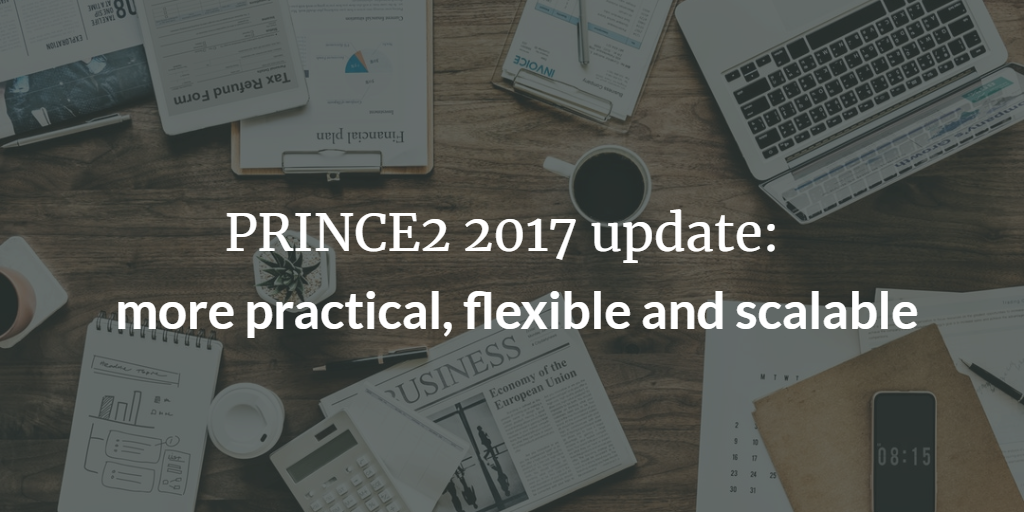Starting point: PRINCE2’s proven strength.
Direct community feedback from practitioners, trainersand consultants made it clear that an evolutionaryupdate was requested, that responds to higherexpectations of stakeholders in today’s working environment. The 2017 update of PRINCE2, that will come out in June 2017, builds on the proven strength of PRINCE2 while responding to current imperatives for flexibility and agility. It does that by putting more emphasis on:
- tailoring PRINCE2 to the needs of the project,
- the principles that underpin PRINCE2 and
- the practical application of the guidance
Together with new Foundation and Practitioner exams,that highlight the core and the practical application, the 2017 PRINCE2 update provides practical, accessible andauthoritative guidance for anyone managing a project. What did not change? The PRINCE2 2017 update does not change the structure of the method, based on the four integrated elements:
- the 7 principles
- the 7 processes
- the 7 themes
- the project environment (tailoring to the…)
This structure was, and is, one of the proven strengths of PRINCE2 – it combines all the essential elements of
project management in an integrated framework that needs to be applied to do a successful project.
What has changed?
The first three integrated elements, the principles, theprocesses and the themes, have not changed much. The Principles are still what they were: the base for the method. The new manual does underline the importance of the principles even more than before, as they are always guiding in tailoring the method and tailoring has become so much more important in this version of PRINCE2. As for the processes, only in the process Initiating a
Project an activity – ‘agree the tailoring requirements’ – has been added, to make sure tailoring is a conscious
decision.
The documents (I should say ‘management products’) did not change much either. The old ‘management strategies’ became ‘management approaches’, except for the ‘configuration management strategy’ that is called ‘change control approach’ now (surely an improvement). The old ‘benefits review plan’ has been renamed ‘benefits management approach’, to emphasize PRINCE2’s link to creating business value. And the ‘project’s product description’, previously in the ‘project brief’, is now part of the ‘outline business case’, because there is more attention to scope and requirements in the business case theme. The themes largely remained as they were, with a couple
of exceptions:
- In the risk theme, the risk responses and the approach to risk have been aligned with M_o_R® (Management of Risk).
- The change theme is much less about configuration management and more about how (and how much) to control change.
- Guidance on planning stages has been moved from the progress theme to the plans theme. The old terminology of ‘technical stages’ (vs. ‘management stages’) has been replaced by ‘delivery steps’ – still as
opposed to ‘management stages’.
- The last of the four integrated elements, tailoring to the project environment, has become much more important.
- The chapter on tailoring, previously somewhere at the back of the manual, has been elaborated and more prominently placed at the beginning of the manual.
- There is clear guidance on how to tailor PRINCE2 to different project environments, like when using an agile approach, in simple projects, projects involving a commercial relationship between customer and supplier, projects within a programme or with multiple owning organizations.
- The distinction between tailoring, adopting and embedding is explained in more detail and there is
guidance on how to adopt and embed PRINCE2 in an organization. This reflects the link to other methods of the Axelos framework, like MSP for programme management, P3O for support offices and continuous
improvement of PPM / P3 management.
- Tailoring comes back in every other chapter. For every theme there is guidance for effective management of the theme in different environments and for the processes there are explicit tailoring guidelines on the process and the management products created.
This heightened attention to tailoring makes the 2017 version of the PRINCE2 manual more practical, flexible and scalable. Thereby PRINCE2 remains the de-facto standard for project management with accessible, authoritative
guidance for organizations and practitioners managing their projects.
Author: Niels van Bemmelen









